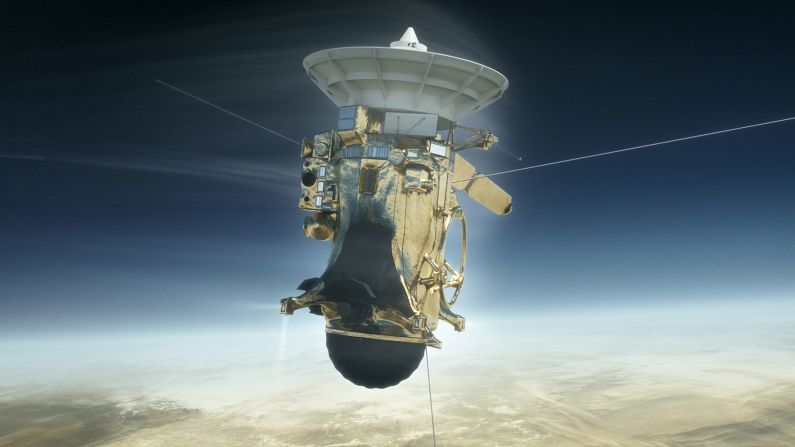
On September 15, 2017, the 20-year Cassini mission ended in a "death dive" into Saturn's upper atmosphere, collecting data until the spacecraft broke apart and became part of the planet it set out to explore.

This is the last image taken by NASA's Cassini spacecraft before it broke apart in Saturn's atmosphere on September 15, 2017. RIP, Cassini!

This is Cassini's final resting place. NASA says the montage of images was created using data from Cassini's visual and infrared mapping spectrometer. What you see in the photo are clouds in the atmosphere, silhouetted against that inner glow, according to NASA.

Cassini captured this image of Saturn's northern hemisphere on September 13, 2017. It is among the last images Cassini sent back to Earth.

Cassini took this final image of Saturn's rings on September 13, 2017 while the spacecraft was 684,000 miles (1.1 million kilometers) away from the planet.

Two days before its death plunge into Saturn, Cassini took this image of Saturn's A ring. The ring features what scientists call a lone "propeller" -- a feature created by small moonlets in the rings.

This image of Saturn's moon, Titan, was among the last obtained by Cassini's narrow-angle camera on September 13, 2017. The images were taken two days before Cassini plunged into Saturn's atmosphere.

Cassini took this image of Saturn's moon Titan in 2012. NASA scientists say they have detected acrylonitrile in Titan's atmosphere. The chemical could possibly form cell membranes. That means, according to scientists, Titan could have the right conditions for life to develop.

On July 19, 2013, Cassini snapped a very special vista of our home world. The spacecraft slipped into Saturn's shadow and, with the sun blocked, it was able to image not only Saturn, but seven of its moons, its inner rings -- and, in the background, Earth and our moon.

Springtime on Saturn: Cassini's wide angle camera shot 75 images showing Saturn, its rings, and some of its moons just after the Spring equinox. An equinox occurs when the sun's disk is exactly over a planet's equator. It takes 30 years for Saturn to orbit the sun, so an equinox occurs every 15 Earth years, NASA says. These images were taken on August 12, 2009, a little more than a day after the exact equinox.

Saturn appears to sit in a nest of rings in this composite of 45 images Cassini took on May 9, 2007. The spacecraft was about 700,000 miles (1.1 million kilometers) from Saturn when the images were taken.

Saturn's moon, Enceladus, is a small, icy world. For scientists, it's also one of the most interesting places in our solar system. Cassini discovered Enceladus is an active moon with a global ocean of liquid salty water beneath its crust. Planetary scientists now think Enceladus may possibly be hospitable to life. "Enceladus discoveries have changed the direction of planetary science," said Cassini project scientist Linda Spilker. This mosaic was created from 21 false-color images taken during Cassini's close approaches to Enceladus on March 9 and July 14, 2005.

This mosaic of nine images shows Saturn's moon Titan during Cassini's first very close flyby on October 26, 2004. The spacecraft was at distances ranging from about 200,000 miles (320,000 kilometers) to 400,000 miles (640,000 kilometers) from Titan when the images were taken.

Saturn's pale colors and its rings come into view as Cassini approaches on May 7, 2004. This composite was made from images taken when Cassini was about 18 million miles (29 million kilometers) from Saturn. It also shows some of Saturn's moons.

The Cassini spacecraft was launched from Cape Canaveral, Florida, on a Titan IVB/Centaur rocket on October 15, 1997. It began orbiting Saturn in 2004.

